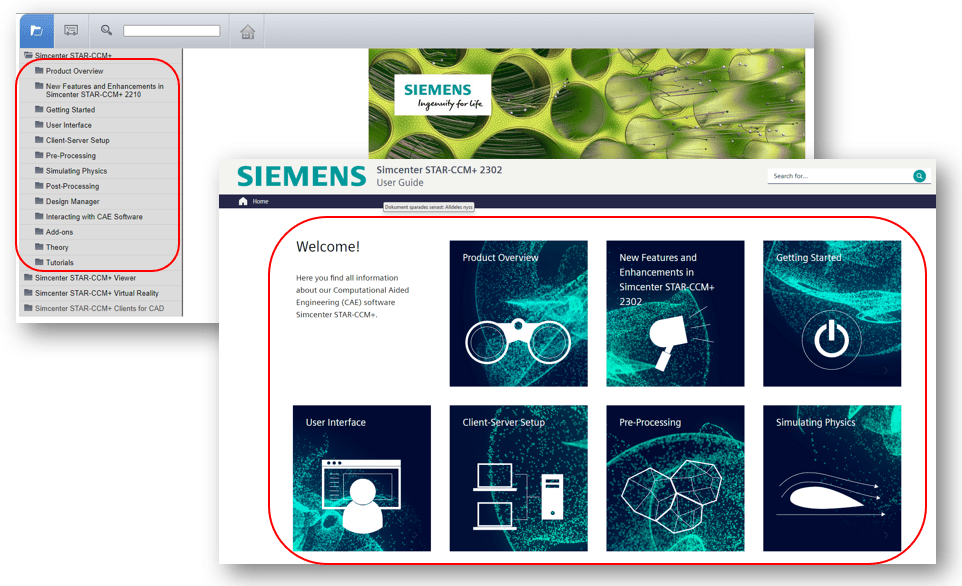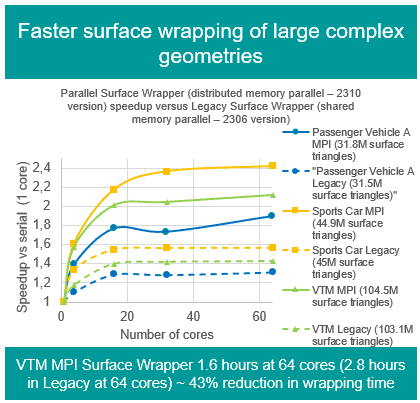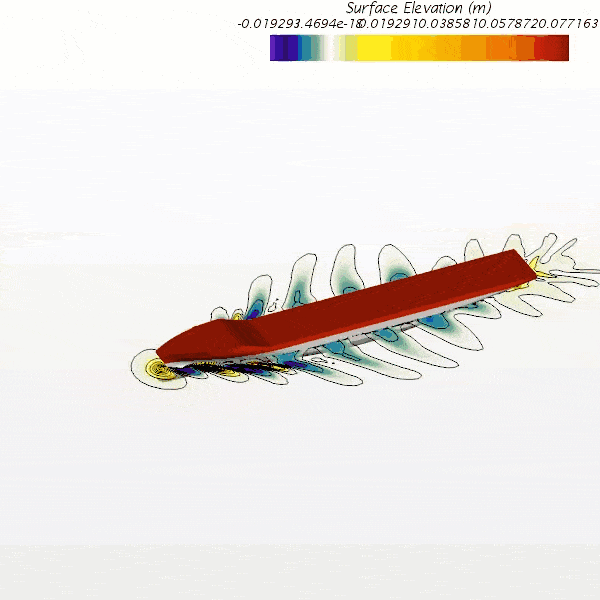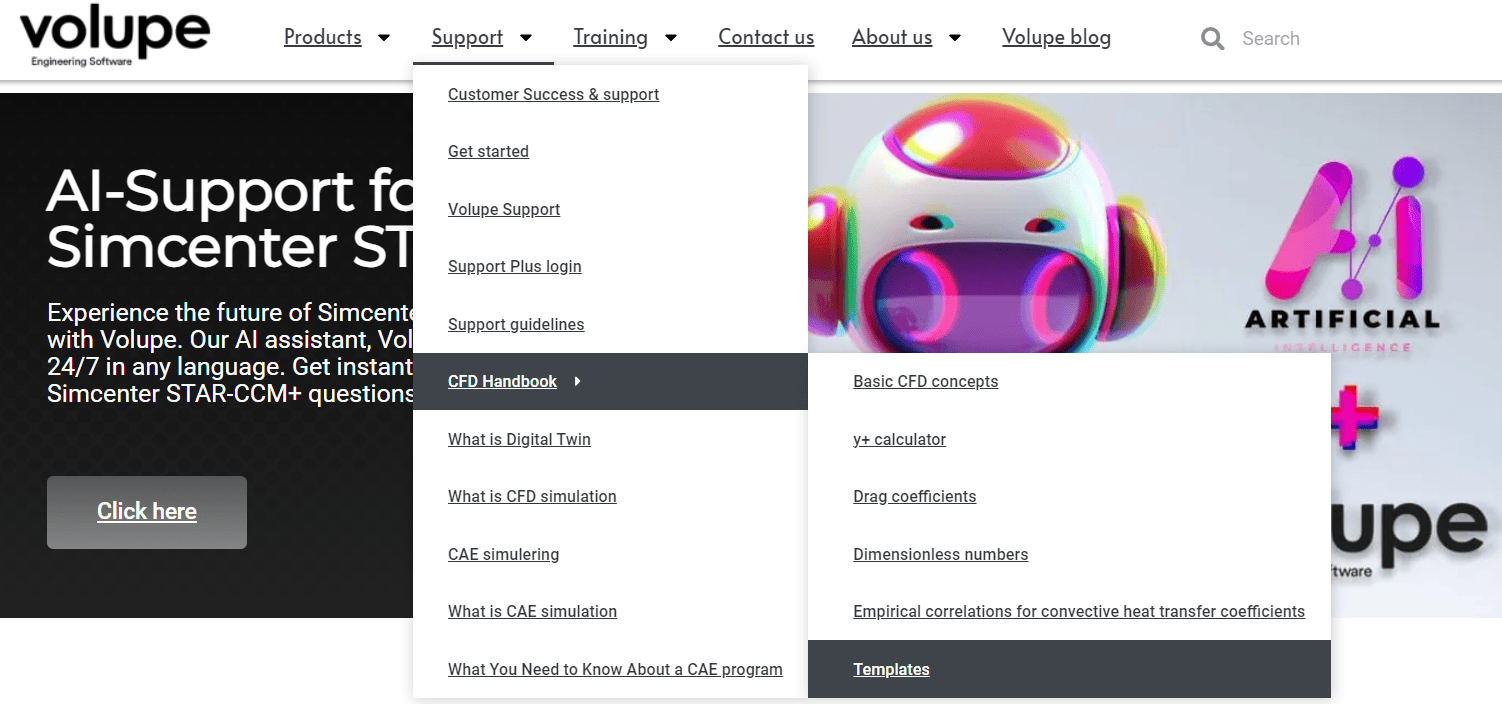The latest version of Simcenter STAR-CCM+, 2302, has been around for some weeks now. I wrote a blog post about the news in that version related to multiphase simulations some time back, that can be found here: Simcenter STAR-CCM+ 2302 multiphase news – VOLUPE Software. My college Florian also wrote a blog post on the DFBI new velocity driver that can be found here: DFBI Velocity Driver – VOLUPE Software. It is a deep dive into that specific functionality.
Aside from the news already handled, this post is to highlight more general news that can be useful to a wide variety of users of the software. The first news will handle user experience related news, some things that are perhaps not “need to have” but “good to have”. The idea is that the sections in this post are, or at least can be, useful to more or less all users.
Simulation guide
This new feature of simulation guide is completely user experience related. This is like the sim-files own internal read-me one can say. But it is also much more. The functionality allows you to store relevant information within your simulation. It is essentially your own internal text editor, and it allows you to write and format text, add images, and tables. It removes the need for PowerPoints and pdf-files with instructions for a certain file or workflow. Moreover, it allows you to create links to the nodes in the simulation tree meaning that when you reach a certain row in your simulation guide, and the instructions are to e.g., fill out a parameter value, you can directly create a link to the property window of that parameter, completely removing the need to go find it in the simulation tree.
The feature is additionally good in relation to template files. Before, usually a custom tree would be the first instance you see in a simt-file, with a customized scene containing the instructions for the file. Things can now be transferred over to the simulation guide, and the need for one or several custom trees can be reduced. It will be easy for the next person to take over and understand the simulation file to and to follow what is happening and they will quickly be up to speed, if the simulation guide is properly filled out. The video below shows an example of how this can work.
In place evaluation for expressions
This might seem like a small thing, but it can remove a lot of additional clicking and scrolling in the tree when evaluating actual values. Before you could only do this in the parameters node tree, but you can now evaluate all values that contain expressions. Like the picture below shows, clicking the “i”-button to the right of the value field will show you the current value of the expression, while hovering over the expression will give you the details about the expression.

Improvements to the user guide (documentation)
While most of the material is the same in the documentation, the layout and format of the documentation has been given a complete overhaul. Not only from a stylish point of view but also in terms of functionality. The picture below shows the start page update between version 2210 and 2302.

The picture below shows a typical page layout now after the changes in version 2302. An interactive “On this page” section has been added for easier overview of the relevant subtopics.

Moreover, the search function has been improved. You now get several suggestions to your search, with a relevance specification. This feature I would suggest you try out yourself, it is not easy to visualize how good the new search feature is, it needs to be experienced.
Region-based meshing retired
We have all been looking at the warning message that turns up upon starting a session in Simcenter STAR-CCM+, saying that region-based meshing is being deprecated and will be removed. And finally, this is the case. As of version 2302, region-based meshing is no longer possible. You can no longer create a Mesh continuum. With this also, feature curves have been removed. If you had a file with the older method used, you can still run the solver with it, but the mesh will be treated as if it was imported.

New gradient-based hybridization scheme
In Simcenter STAR-CCM+, in addition to variable values, variable gradients are required at cell centers and at cell-face centers for e.g., construction of variable values at the cell faces, secondary gradients calculation for diffusion terms and pressure gradients calculation for pressure. The old method that was a Least Squares – Green Gauss hybrid scheme has been replaced with a pure Least Squares method. In the old method the blending factor was based on mesh heuristics, but that has now been replaced by a single criterion. This reduces the user input for the gradient solver and fewer cells will be selected for blending. The blending function is now smoother compared to the old one, because there was an abrupt switch from Least Squares to Green Gauss. And the smoothness also provides robustness in the solver. The blending is now between pure area-weighted Least Squares and zero-gradient condition. This will lead to a reduction of blended cells and the accuracy of results will improve.
The picture below shows (on the top) a comparison between the residuals and the result of a full speedline for a 4.5 stages axial compressor. The residual plot shows a clear improvement of convergence across all operating points of the compressor speedline. The right graph also shows that the accuracy of the results has increased with the implementation of this new gradient hybridization scheme. The lower part of the picture shows the change to the expert properties for the gradient solver. The left side shows the options before the change and the right side shows the current settings. The first one is the Maximum Reconstruction Coefficient, used as criterion to select the cells for blending. The Reconstruction Coefficient is a measure of the sensitivity of the reconstructed gradients on a face with respect to the gradients of the neighbor cells. By setting the Maximum Reconstruction Coefficient to 1 (default) we are effectively applying a limiter to this sensitivity. In order to enhance the stability of the simulation, it can be lowered, meaning that more cells are selected for blending. However, it is not advisable to go below a value of 0.5, after which accuracy might be compromised.

I hope these news will be helpful to you, and that you take opportunity of the new features in this version. And as usual, do not hesitate to reach out to support@volupe.com with any questions. Do not forget also to eat your fill of eggs over Easter.
Author

Robin Victor
+46731473121
support@volupe.com



